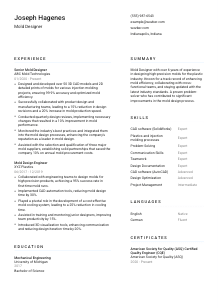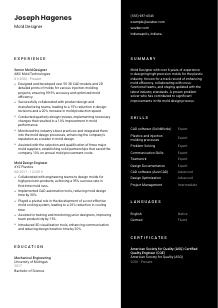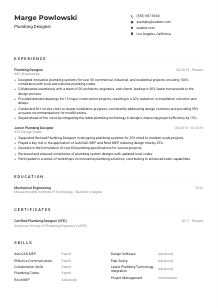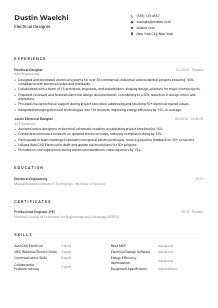Mold Designer Resume Example
Molding creativity, but your resume looks a little bland? Shape up your credentials with this Mold Designer resume example, sculpted using Wozber free resume builder. See how to cast your design skills into a format that fits with job expectations, molding your career for success!

How to write a Mold Designer Resume?
Embarking on the journey to land your dream Mold Designer position? With the job market as competitive as ever, presenting a powerful resume is key. This guide will delve into the secrets of creating a resume that not only meets but exceeds the expectations for a Mold Designer role.
Using the Wozber free resume builder, we'll show you how to construct an ATS-compliant resume that shines. Prepare to transform your professional narrative into one that captures the eye of every hiring manager.
Personal Details
The foundation of your resume begins with your personal details. It's the initial handshake with your potential employer. Below, we'll explore how to fine-tune this section to ensure a strong first impression, aligning every detail with the Mold Designer position.
1. Name with Impact
Your name is the headline of your professional story. To make it stand out, opt for a clean, prominent typography that sets it apart from the rest of your resume. This isn't just about aesthetics; it's about ensuring your brand catches the hiring manager's attention from the get-go.
2. Tailor Your Job Title
"Mold Designer" isn't just the job you're applying for—it's a title that encompasses your skills, experience, and the value you bring. Position it just below your name to create an immediate connection with the job description and signal your suitability for the role.
3. Essential Contact Info
In the realm of contact information, less is more. A phone number and a professional email address are must-haves. Opt for an email format that's simple yet professional - yourname@email.com speaks volumes about your seriousness towards your career.
4. Location Relevance
The job description notably mentions Indianapolis, Indiana. Highlighting your current location as Indianapolis shows readiness and availability, eliminating any concerns about relocation or availability—that's one less hurdle in your application journey.
5. Professional Online Presence
A LinkedIn profile or personal website showcasing your portfolio can be a game-changer. It's an extended space to narrate your professional story, display your projects, and demonstrate your prowess in mold design. Ensure it's current and reflects the strengths highlighted in your resume.
Takeaway
Think of the Personal section as the door to your professional world. It's simple, yet pivotal. By aligning it with the specific requirements for the Mold Designer role, you're not just filling out a template; you're strategically positioning yourself for the role. Remember, first impressions count, so make every word in this section purposeful.





Experience
The Experience section is where your resume really starts to take shape. It's your professional narrative, where you can align past roles and accomplishments with the demands of a Mold Designer role. Let's dive into making your experience speak the language of success.
- Designed and developed over 50 3D CAD models and 2D detailed prints of molds for various injection molding projects, ensuring 99.9% accuracy and optimized mold efficiency.
- Successfully collaborated with product design and manufacturing teams, leading to a 15% reduction in design revisions and a 20% increase in mold production speed.
- Conducted quarterly design reviews, implementing necessary changes that resulted in a 10% improvement in mold performance.
- Monitored the industry's best practices and integrated them into the mold design processes, enhancing the company's reputation as a leader in mold design.
- Assisted with the selection and qualification of three major mold suppliers, establishing solid partnerships that saved the company 10% on annual mold procurement costs.
- Collaborated with engineering teams to design molds for high‑precision products, achieving a 95% success rate in first‑time mold runs.
- Implemented CAD automation tools, reducing mold design time by 30%.
- Played a pivotal role in the development of a cost‑effective mold cooling system, leading to a 25% reduction in cooling time.
- Assisted in training and mentoring junior designers, improving team productivity by 15%.
- Introduced 3D visualization tools, enhancing communication and reducing design iteration time by 20%.
1. Align with Job Requirements
Start by breaking down the job post. Highlight keywords and phrases directly related to mold design tasks, such as "design and develop 3D CAD models," and ensure your experience echoes these responsibilities. This makes it crystal clear that you're not just a fit—you're a perfect match.
2. Chronology and Clarity
Structure your experience in reverse chronological order, highlighting your trajectory in the mold design sphere. For each role, clearly state your job title, the company's name, and the tenure to construct a clear, understandable professional timeline.
3. Accomplishments that Resonate
For each position, focus on specific achievements that mirror the job requirements. Did you enhance mold efficiency? Collaborate to reduce design revisions? Quantify these successes to offer tangible proof of your impact. This is your moment to shine; make every word count.
4. Quantify Your Impact
Numbers speak volumes. Whether it's the number of models designed, the percentage increase in production speed, or cost savings achieved through supplier negotiations—quantifying your accomplishments makes your contribution tangible and memorable.
5. Relevancy is Key
Channel your inner mold designer and be selective about what experiences you include. Focus on those directly related to mold design and the plastic industry. This isn't the place for unrelated achievements, no matter how proud of them you are.
Takeaway
Crafting an experience section that resonates with hiring managers is about more than listing past job titles. It's about painting a picture of a seasoned professional with a track record of meaningful, relevant contributions. Make it impossible for them to overlook the value you'd bring as their next Mold Designer.
Education
The Education section of your resume provides a backbone to your professional expertise, especially in a technical field like mold design. Here's how to refine this section to illuminate your fit for the Mold Designer role.
1. Highlight Key Requirements
The job description calls for a "Bachelor's degree in Mechanical Engineering or a related field." If your degree aligns, make it the centerpiece of your education section—front and center, ensuring it's impossible to miss.
2. Structure with Precision
Keep this section straightforward and readable. List your degree, field of study, the institution you graduated from, and your graduation date. This isn't the place for flourish; clarity is your ally.
3. Tailor Your Degree Details
For the role of Mold Designer, emphasizing a Bachelor of Science in Mechanical Engineering underscores your foundational knowledge in the field. If your degree is directly relevant, it's a powerful indicator of your preparedness for the technical demands of the position.
4. Relevant Courses and Achievements
While the broad stroke of your degree is most important, don't hesitate to highlight specialized courses or projects that align with mold design. This can be particularly compelling if you're at the early stages of your career.
5. Beyond the Degree
Were you involved in engineering clubs, organizations, or did you partake in relevant contests or hands-on projects? Such details, while succinct, can add a layer of interest and show your enthusiasm and initiative within your field.
Takeaway
Your education isn't just a list of schools and degrees; it's a testament to your preparation for the Mold Designer role. By focusing on the details most relevant to the position, you craft an Education section that bolsters your candidacy and aligns you closer to the role.
Certificates
In the rapidly evolving world of mold design, certifications can set you apart as a dedicated and knowledgeable professional. Here's how to navigate the Certificates section to highlight your continuous learning and specialization.
1. Identify Key Job Certificates
The job post lists "Relevant certifications in Mold Design" as a desirable attribute. Directly referencing certifications like the ASQ Certified Quality Engineer indicates a match between your qualifications and the job's requirements.
2. Prioritize Relevant Certifications
Your resume is a snapshot of your professional persona, so include certificates that best speak to the Mold Designer role. Showcasing relevant certifications upfront demonstrates your commitment and specialized knowledge in the field.
3. Dates Matter
For certificates, especially those with expiration dates, include the date of certification. This not only shows you are current but also that you take the initiative to keep your skills sharp and relevant.
4. Continuous Learning
The world of mold design doesn't stand still, and nor should you. Staying on top of emerging trends and technologies through ongoing certification demonstrates your dedication to excellence and adaptability in the field.
Takeaway
Certificates are more than just accolades; they are proof of your ongoing dedication to your craft. By strategically presenting certifications related to the Mold Designer role, you highlight your commitment to quality, efficiency, and continuous improvement.
Skills
The Skills section of your resume is a concise showcase of your professional capabilities. In this segment, we'll guide you through selecting and presenting skills that resonate with the unique requirements of a Mold Designer.
1. Decode the Job Post
Begin by identifying both the hard and soft skills mentioned in the job description. Hard skills like "CAD software proficiency" and soft skills such as "excellent problem-solving" are crucial. Make a list that mirrors these, ensuring your skills matrix aligns with the employer's needs.
2. Select Pertinent Skills
From your list, choose the skills that are most relevant and where you excel. Remember, quality trumps quantity. Highlighting expertise in "CAD software (SolidWorks, AutoCAD)" and your capability in "problem-solving" and "teamwork" speaks volumes to your fit for the role.
3. Organization and Presentation
Structure your skills in a way that makes them easy to skim. Group them into logical categories, like technical skills and interpersonal skills, to provide a clear picture of your well-rounded capabilities. This organized showcase makes it easier for hiring managers to spot the perfect match.
Takeaway
The Skills section is your chance to showcase your proficiency in mold design. It's where you prove that you not only have the technical chops but also the collaborative spirit to excel as a Mold Designer. Present your skills with confidence, spotlighting why you're the best fit for the role.
Languages
In the globalized industry of mold design, language skills can significantly broaden your horizons and enhance your professional value. Here's how to leverage your linguistic abilities for the Mold Designer position.
1. Scrutinize the Job Requirements
If the job listing specifies language skills, like the mandatory "English", it's crucial to highlight your proficiency at the top. This instantly assures the hiring manager of your ability to communicate effectively in the workplace.
2. List Vital Languages First
Begin with language skills explicitly mentioned in the job description and then list any additional languages. For a Mold Designer, proficiency in English is a must, but additional languages showcase your potential for collaborative work in diverse teams or with international suppliers.
3. Language Proficiency Ratings
Be clear about your level of proficiency in each language. Use terms like native, fluent, intermediate, and basic to provide a quick understanding of your abilities. This clarity is appreciated and can sometimes tip the scales in your favor.
4. Role-Relevant Linguistic Abilities
While not always listed as a requirement, the ability to communicate in multiple languages is a coveted soft skill in mold design. This can be especially valuable in roles requiring interaction with international teams or clients.
5. Honesty is the Best Policy
It's crucial to be honest about your language proficiency. Overstating your abilities can lead to uncomfortable situations that could have been avoided. Integrity in your language skills paints you as a reliable candidate.
Takeaway
While primarily a technical profession, the ability to communicate across languages can enhance your appeal as a candidate for the Mold Designer role. It adds an extra layer of versatility to your resume, showcasing you as a professional poised for challenges in the global arena.
Summary
Your resume summary is your chance to engage the hiring manager, providing a bird's eye view of your qualifications and setting the tone for the rest of your resume. Here's how to create a summary that resonates for the Mold Designer position.
1. Grasp the Job Essence
Begin by absorbing the core demands and spirit of the Mold Designer role as described in the job description. This understanding lays the groundwork for a summary that not only reflects your qualifications but also your deep alignment with the role.
2. Start with a Strong Introduction
Kick off your summary by stating your professional identity and years of experience. A phrase like "Mold Designer with over 6 years of experience" instantly conveys your role-specific expertise, making a strong first impression.
3. Address Key Points
Highlight your most relevant skills, accomplishments, and qualities that align with the job description. Mention your proficiency in CAD software, your contributions to improving mold design processes, and your ability to work seamlessly with cross-functional teams.
4. Be Concise and Impactful
The power of a great summary lies in its brevity and impact. Keep it concise, aiming for three to five lines that encapsulate your professional essence. This teaser sets the stage for the detailed narrative that follows in the rest of your resume.
Takeaway
Consider your summary as the handshake that introduces you to the hiring manager. It's your chance to make a memorable first impression, highlighting why you're the ideal candidate for the Mold Designer role. Craft it with care, making it impossible for them to pass you by.
Launching Your Mold Designer Journey
Congratulations on taking this comprehensive journey through each section of your resume! With this guide, you're well-equipped to create a resume that not only meets but surpasses the expectations for a Mold Designer role. Remember, your resume is more than just a document—it's a narrative of your professional excellence.
Use the Wozber free resume builder, including its free ATS-friendly resume templates and ATS resume scanner, to ensure your resume is not just seen but also remembered. Here's to you, stepping in confidently to claim your next career milestone as a Mold Designer.

- Bachelor's degree in Mechanical Engineering or a related field.
- Minimum of 5 years of experience in mold design using CAD software, preferably SolidWorks or AutoCAD.
- Strong knowledge of plastics and injection molding processes.
- Excellent problem-solving and communication skills, with a team-oriented mindset.
- Relevant certifications in Mold Design such as American Society for Quality (ASQ) Certified Quality Engineer (CQE) or equivalent.
- English language skills are mandatory.
- Must be located in or willing to relocate to Indianapolis, Indiana.
- Design and develop 3D CAD models and 2D detailed prints of molds for injection molding processes.
- Collaborate with cross-functional teams including product design, manufacturing, and tooling engineering to ensure mold design feasibility and optimization.
- Conduct regular design reviews, making necessary changes and improvements to enhance mold efficiency and performance.
- Monitor and stay updated with the latest industry standards, regulations, and best practices related to mold design and manufacturing.
- Assist with the selection and qualification of mold suppliers, providing necessary specifications and documentation.















